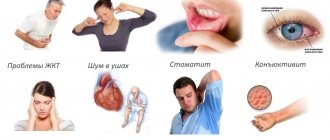Zofran
The choice of dosage regimen is determined by the severity of the emetogenic effect of the antitumor therapy performed.
For adults, the daily dose is 8-32 mg/day, the following regimens are recommended.
With moderate severity of the emetogenic effect of chemotherapy or radiotherapy - 8 mg intravenously in a slow stream or intramuscularly, immediately before starting therapy.
If the emetogenic effect of chemotherapy is significant: 8 mg is administered slowly intravenously immediately before the start of chemotherapy, and then 8 mg is administered intravenously every 2-4 hours;
or intravenous drips continuously at a rate of 1 mg/hour for 24 hours;
or drip immediately before the start of chemotherapy at a dose of 16-32 mg, diluted in 50-100 ml of the appropriate infusion solution, for 15 minutes.
The effectiveness of odansetron can be increased by a single intravenous administration of corticosteroids (for example, 20 mg dexamethasone) before starting chemotherapy.
To prevent delayed vomiting that occurs 24 hours after the start of chemotherapy or radiotherapy, it is recommended to take the drug in tablet form, both with strong and moderate severity of the emetogenic effect of the therapy.
For oral administration: adults, for the prevention of nausea and vomiting during chemotherapy or radiotherapy, the drug is prescribed 8 mg 1-2 hours before the start of antitumor therapy, followed by another 8 mg orally after 12 hours. For the prevention of late (after 24 hours ) or prolonged vomiting, you should continue taking 8 mg 2 times a day for 5 days after the end of the course of antitumor therapy. To enhance the effect, the single dose can be increased to 24 mg and administered simultaneously with 12 mg of dexamethasone phosphate (in the form of sodium salt) 1-2 hours before the start of chemotherapy.
Children over 2 years of age: IV at a dose of 5 mg/sq.m of body surface immediately before chemotherapy, followed by oral administration at a dose of 4 mg after 12 hours. After completing the course of chemotherapy, it is necessary to continue taking the drug at a dose of 4 mg 2 times a day within 5 days.
Prevention of postoperative nausea and vomiting:
During induction of general anesthesia, adults are administered intramuscularly or intravenously (slowly) at a dose of 4 mg.
To treat nausea and vomiting that occurs, slow administration of 4 mg of the drug is recommended intramuscularly or intravenously.
The drug can be administered intramuscularly into the same area of the body in a dose not exceeding 4 mg.
For children, to prevent postoperative nausea and vomiting, the drug is used exclusively parenterally, in a single dose of 0.1 mg/kg (maximum 4 mg) slowly intravenously before or after anesthesia.
For the treatment of developed postoperative nausea and vomiting in children, slow intravenous administration of a single dose of 0.1 mg/kg (maximum up to 4 mg) is recommended.
There is insufficient experience with the prevention and treatment of postoperative nausea and vomiting in children under 2 years of age.
In case of kidney damage and in elderly patients, adjustment of the usual daily dose and frequency of administration of the drug is not required.
With liver damage, the clearance of the drug is significantly reduced, its T1/2 from plasma increases and a dose reduction to 8 mg/day is required.
Side effects of Zofran™
They are classified according to organs and systems and the frequency of their occurrence. By frequency they are divided into the following categories: very often (≥1/10), often (≥1/100, but ≤1/10), infrequently (≥1/1000, but ≤1/100), rarely (≥1/10 000, but ≤1/1000), very rare (≤1/10,000, including isolated cases). Immune system: rarely , including anaphylaxis. Nervous system: very often - headache, often - movement disorders (including extrapyramidal disorders, such as oculogyric crisis, dystonic reactions) and dyskinesia without persistent clinical consequences, convulsions, rarely - dizziness during rapid intravenous administration of the drug. Organ of vision: rarely - transient visual disturbances (blurred vision), most often with rapid intravenous administration, very rarely - transient blindness, mainly with intravenous administration. In most cases, blindness disappears within 20 minutes after the end of the drug administration. As a rule, most patients receive chemotherapy with cisplatin. Some reports believed that cases of transient blindness were of cortical origin. Cardiovascular system: infrequently - arrhythmias, pain in the heart region (with ST ), bradycardia, hypotension, often - a feeling of warmth or flushing of the face. Respiratory system and chest organs: infrequently - hiccups. Gastrointestinal tract: often - constipation. Hepatobiliary system: uncommon - transient asymptomatic increase in transaminase activity in the blood serum. These cases occur primarily in patients receiving cisplatin chemotherapy. General disorders: often - local reactions in the injection area.
Overdose
There is not enough information about Zofran overdose. In most cases, symptoms are similar to those that occur as side effects when administered at recommended doses. Ondansetron increases the QT interval in a dose-dependent manner. If an overdose occurs, conduct an ECG examination. Among the phenomena of overdose, visual disturbances, hypotension, and severe constipation were more often noted. In all cases, the symptoms quickly passed. There is evidence of the appearance of serotonin syndrome in young children after an overdose.
No special antidote has been developed. In case of overdose, begin symptomatic therapy. Follow-up examination and treatment of patients is carried out according to clinical indications. The use of ipecac to treat symptoms of overdose is not recommended.
Reviews and recommendations from doctors and patients
The medication Zofran, reviews of which are extremely positive and confirm its effectiveness, is a good remedy and has a minimum number of contraindications. There are features of combined use with other medications, but in general there are no problems with taking it.
Zofran solution, reviews of which can be found both on forums and on social networks, has the following effects:
- reduces the patient’s psychomotor activity;
- fights vomiting and nausea;
- improves well-being after chemotherapy.
The effectiveness of the drug has been proven by clinical trials and experiments. The majority of patients who used Zofran noted an improvement in their condition after radiation therapy and chemotherapy, a significant improvement in the quality of life, and a rapid return to a normal lifestyle. Pay attention to elderly patients and children. Do not use the drug without a doctor's instructions.
pharmachologic effect
Ondansetron is a powerful, highly selective 5HT3 receptor blocker. The medication prevents and fights vomiting and nausea caused by cytotoxic chemotherapy or radiation therapy. Also combats vomiting and nausea after surgery.
The mechanism of action of the active ingredient has not been fully studied. There is an assumption that the medication blocks the manifestation of the gag reflex, revealing an antagonistic effect on 5HT3 receptors, which are located in nerve cells of the peripheral and central nervous system. The medication reduces the patient's excitatory activity and does not provoke a sedative effect.
Compound
- 1 ml of Zofran solution contains 2 mg of ondansetron . Additional substances: sodium citrate, citric acid monohydrate, water, sodium chloride.
- One Zofran lozenge may contain 4 or 8 mg of ondansetron . Additional substances: aspartame , mannitol, gelatin, sodium propyl hydroxybenzoate, sodium methylhydroxybenzoate, water, strawberry flavor.
- 5 ml of Zofran syrup contains 4 mg of ondansetron . Additional substances: sodium citrate dihydrate, citric acid, sodium benzoate, water, strawberry flavor, sorbitol solution.
- 1 suppository for rectal administration of the drug Zofran contains 16 mg of ondansetron. Additional substances: vitepsol S58.
Drug interactions Zofran™
Ondansetron does not accelerate or inhibit the metabolism of other drugs when used simultaneously. Special studies have shown that ondansetron does not interact with alcohol, temazepam, furosemide, tramadol and propofol. Ondansetron is metabolized by a variety of liver cytochrome P459 enzymes: CYP 3A4, CYP 2D6 and CYP 1A2. Due to the diversity of ondansetron metabolic enzymes, inhibition or reduction in the activity of one of them (for example, genetic deficiency of CYP 2D6) is under normal conditions compensated by other enzymes and will have no or negligible effect on total creatinine clearance. Phenytoin, carbamazepine and rifampicin In patients receiving therapy with drugs that are potential inducers of CYP 3A4 (for example, phenytoin, carbamazepine and rifampicin), the clearance of ondansetron increases and its concentration in the blood decreases. Tramadol According to a small number of clinical studies, ondansetron may reduce the analgesic effect of tramadol.
Use during pregnancy and breastfeeding
The safety of using Zofran while pregnant and breastfeeding has not been determined. During animal experiments, the drug did not disrupt the growth of the embryo or fetus, and did not have an effect on the course of pregnancy. But since any animal studies are not always predictive for humans, Zofran is not recommended for use during pregnancy.
Also during experiments it was found that the active component ends up in animal milk. If drug therapy is necessary, feeding should be stopped for a while.
Release form
- Solution for injection is a clear, colorless liquid, almost free of inclusions. 2 or 4 ml of solution in an ampoule; 5 ampoules in contour packaging; 1 pack in a paper bundle.
- White tablets are round in shape, with convex and flat surfaces. 10 tablets in a blister; 1 blister in a pack of paper.
- Syrup is a transparent liquid without color or with a yellowish tint and the smell of strawberries. 50 ml of liquid in a bottle; 1 bottle with measuring spoon in a paper pack.
- White candles of a homogeneous structure, having a standard shape. One candle per strip; 1 or 2 strips in a paper pack.
special instructions
During treatment of patients with manifestations of excessive sensitivity to other selective 5HT3 receptor antagonists, hypersensitivity reactions occurred. Reactions that are associated with the respiratory system are treated symptomatically. Health care providers should pay special attention to these patients as they are symptomatic of drug oversensitivity reactions.
In people undergoing adenotonsillar surgery, using ondansetron to prevent vomiting and nausea may mask bleeding. That is why such people need double control after the administration of this active substance.
In children who are treated with hepatotoxic chemotherapeutic drugs, pay special attention to possible changes in the liver. The dosage is calculated according to body weight.
Ondansetron increases colonic transit time, so close monitoring will be required when using the drug in patients with symptoms of subacute intestinal obstruction.
Zofran is not recommended to be administered in the same syringe with other medications. Currently, there is limited information on the use of the active substance in infants under 1 month of age.





